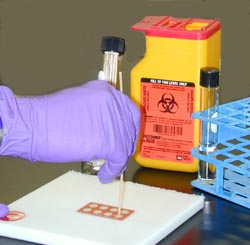Chapter 11 Lab Exercises
Section 10 Harvesting and Dispersing of Cells from Biofilms (Standard Method)
Page 3 Student
Copyright © Alfred B. Cunningham, John E. Lennox, and Rockford J. Ross, Eds. 2001-2010
Harvesting and Dispersing of Cells from Biofilms (Standard Method)
Student Version (go to Instructor Version)
Supplies Needed:
|
Quantity |
Description |
| 1 | wooden applicator stick |
| 4 | sterile culture tubes |
| 1 | flask containing sterile distilled water or phosphate buffered saline, for making dilution tubes |
| 1 | mechanical pipetting device and sterile pipette or an automatic pipetter, pipette and pipette tip |
| 1 | biohazard bag for disposal of used tips |
| 1 | Vortex mixer |
| 1 | Branson or equivalent sonic cleaning water bath |
| 1 | forceps/hemostat |
| 1 | microscope slide, coupon or other object with biofilm attached |
Instructions:
Harvesting Cells: Standard Method
- Using a sterile pipette and mechanical pipetting device. Dispense 9ml of distilled water or phosphate buffered saline (PBS) into sterile serological tubes. These will be used as dilution blanks.
- Select a slide or coupon bearing an established biofilm. Hold the slide with a flame sterilized hemostat/forceps.
- Remove the cap from the tube containing the sterile wooden applicator sticks and gently shake the sticks so that one end extends a short distance from the tube. Being careful to touch only one stick, remove it from the tube.
- Using the applicator stick as a scraper, rub the
surface of the coupon for approximately 15 seconds. Be sure
to hold the stick perpendicular to the coupon surface so
that the flat end of the stick is doing the scraping.
Occasionally transfer the material removed to one of the 9
ml dilution tube prepared previously. Swirl the applicator
stick vigorously to remove the biofilm.
Note: you may not be able to see any visible material on the stick or in the diluent as the stick is rinsed. Repeat this process at least 3-4 times (as indicated by your instructor) to ensure full coverage of the coupon surface or defined area being sampled.
- Using a sterile pipette and mechanical pipetting device, rinse the scraped area several times with aliquots of sterile distilled water or PBS. This rinse water should be added to the 9 ml dilution blank. The total volume of rinse water should be 1 ml, making the final volume of the tube 10 ml (for example rinse 4 times with 0.25 ml aliquots, and add these to the dilution tube).
- Dispose of the contaminated applicator stick, pipette, scraped slide in the biohazard bag provided.
Dispersing Cells: Sonicator Method
This technique uses a Fisher Scientific, a Branson Ultrasonic Corporation or similar sonic water bath cleaner delivering approximately 50-60 hz, to disrupt biofilms and disperse cells.
- Place a 150 ml beaker in the sonic water bath and fill the beaker with water so that the volume of the beaker is brought up to the level of water in the cleaner.
- Place your tube (containing the biofilm harvested in the previous section) in the beaker and sonicate for 2 minutes. Turn off sonicator before removing tubes.
- Note: the time required for disruption of the biofilm varies with the material and the appropriate time for any particular specimen should be determined by the instructor.
- The cells should now be dispersed and ready for the next procedure.
- The dilution tube should be vortex mixed before proceeding to dilution and plating to ensure that the dispersed cells are uniformly distributed.
Illustration:

Figure 1. Scraping a coupon.
Educational Program Curricula and Teaching Resources
Supported in part by the Waksman Foundation for MicrobiologyDeveloped in collaboration with Dr. John Lennox, Penn State University-Altoona
©1999-2006 Center for Biofilm Engineering, http://www.erc.montana.edu
